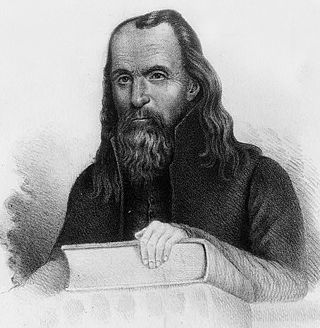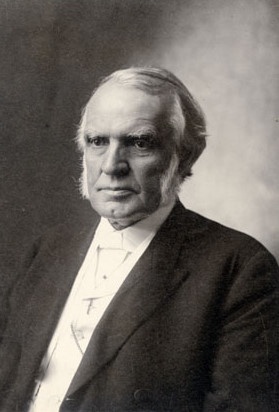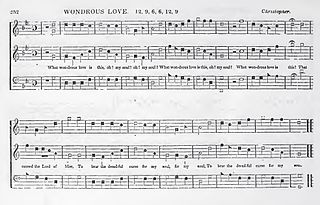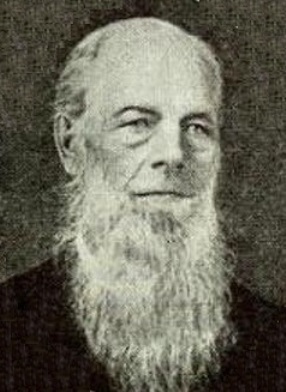Related Research Articles
Methodism, also called the Methodist movement, is a Protestant Christian tradition whose origins, doctrine and practice derive from the life and teachings of John Wesley. George Whitefield and John's brother Charles Wesley were also significant early leaders in the movement. They were named Methodists for "the methodical way in which they carried out their Christian faith". Methodism originated as a revival movement within Anglicanism originating out of the Church of England in the 18th century and became a separate denomination after Wesley's death. The movement spread throughout the British Empire, the United States and beyond because of vigorous missionary work, and today has about 80 million adherents worldwide.

The Second Great Awakening was a Protestant religious revival during the late 18th to early 19th century in the United States. It spread religion through revivals and emotional preaching and sparked a number of reform movements. Revivals were a key part of the movement and attracted hundreds of converts to new Protestant denominations. The Methodist Church used circuit riders to reach people in frontier locations.
The Methodist Episcopal Church (MEC) was the oldest and largest Methodist denomination in the United States from its founding in 1784 until 1939. It was also the first religious denomination in the US to organize itself nationally. In 1939, the MEC reunited with two breakaway Methodist denominations to form the Methodist Church. In 1968, the Methodist Church merged with the Evangelical United Brethren Church to form the United Methodist Church.
The Holiness movement is a Christian movement that emerged chiefly within 19th-century Methodism, and to a lesser extent influenced other traditions such as Quakerism, Anabaptism, and Restorationism. The movement is historically distinguished by its emphasis on the doctrine of a second work of grace, which is called entire sanctification or Christian perfection. Churches aligned with the holiness movement additionally teach that the Christian life should be free of sin. For the Holiness movement, "the term 'perfection' signifies completeness of Christian character; its freedom from all sin, and possession of all the graces of the Spirit, complete in kind." A number of evangelical Christian denominations, parachurch organizations, and movements emphasize those beliefs as central doctrine.

Peter Cartwright,, also known as "Uncle Peter", "Backwoods Preacher", "Lord's Plowman", "Lord's Breaking-Plow", and "The Kentucky Boy", was an American Methodist, revivalist, preacher, in the Midwest, as well as twice an elected legislator in Illinois. Cartwright, a Methodist missionary, helped start America's Second Great Awakening, personally baptizing twelve thousand converts. Opposed to slavery, Cartwright moved from Kentucky to Illinois, and was elected to the lower house of the Illinois General Assembly in 1828 and 1832. In 1846 Abraham Lincoln defeated Cartwright for a seat in the United States Congress. As a Methodist circuit rider, Cartwright rode circuits in Kentucky and Illinois, as well as Tennessee, Indiana and Ohio. His Autobiography (1856) made him nationally prominent.

Lorenzo Dow was an eccentric itinerant American evangelist, said to have preached to more people than any other preacher of his era. He became an important figure and a popular writer. His autobiography at one time was the second best-selling book in the United States, exceeded only by the Bible.

The camp meeting is a form of Protestant Christian religious service originating in England and Scotland as an evangelical event in association with the communion season. It was held for worship, preaching and communion on the American frontier during the Second Great Awakening of the early 19th century. Revivals and camp meetings continued to be held by various denominations, and in some areas of the mid-Atlantic, led to the development of seasonal cottages for meetings.
The Primitive Methodist Church is a Methodist Christian denomination within the holiness movement. It began in England in the early 19th century, with the influence of American evangelist Lorenzo Dow (1777–1834).

Primitive Methodism was a major movement in English and Welsh Methodism from about 1810 until the Methodist Union in 1932. It emerged from a revival at Mow Cop in Staffordshire. Primitive meant "simple" or "relating to an original stage"; the Primitive Methodists saw themselves as practising a purer form of Christianity, closer to the earliest Methodists. Although the denomination did not bear the name "Wesleyan", Primitive Methodism was Wesleyan in theology, in contrast to the Calvinistic Methodists.

Nathan Bangs was an American Christian theologian in the Methodist tradition and influential leader in the Methodist Episcopal Church prior to the 1860s.

Circuit riders were clergy assigned to travel around specific geographic territories to minister to settlers and organize congregations. Circuit riders were clergy in the Methodist Episcopal Church and related denominations, although similar itinerant preachers could be found in other faiths as well, particularly among minority faith groups. They were most prominent during the early years of the United States, from 1784–1830, and were part of the Second Great Awakening revival movement.

Charles Cardwell McCabe, also known as "Bishop" C. C. McCabe and Chaplain C. C. McCabe, was an American who distinguished himself as a Methodist pastor, an Army chaplain during the American Civil War, a Church executive chiefly in the field of fundraising, as chancellor of American University, and as a bishop of the Methodist Episcopal Church (M.E.), elected in 1896. McCabe was credited by Julia Ward Howe as having popularized her famous piece "The Battle Hymn of the Republic" after his imprisonment by the Confederates in Libby Prison during the Civil War.
William Clarke Hauser was an American minister, medical doctor, teacher, composer, and music publisher.

Hugh Bourne along with William Clowes was the joint founder of Primitive Methodism, the largest offshoot of Wesleyan Methodism and, in the mid-19th century, an influential Protestant Christian movement in its own right.

John Early was instrumental in organizing the Methodist Episcopal Church, South, and was their bishop from 1854.
The tiny hamlet of Ramsor in North Staffordshire played a significant part in the origins of Primitive Methodism. Listed in the Domesday Book as Ramshorn, this ancient hamlet is a typical example of the depopulation of the countryside. Very little now remains of this village apart from a few farms and cottages. The Primitive Methodist Chapel is the only surviving public building.
Hezekiah Calvin Wooster was a circuit rider in the Methodist Episcopal Church. He was one of the first Methodists to preach in Upper Canada, where his straightforward style of preaching that appealed to direct emotional connection to God allowed him to convert many of the inhabitants.

"What Wondrous Love Is This" is a Christian folk hymn from the American South. Its text was first published in 1811, during the Second Great Awakening, and its melody derived from a popular English ballad. Today it is a widely known hymn included in hymnals of many Christian denominations.

Lewis Hartsough was a Methodist evangelist and gospel song writer.

Ann Carr was a British evangelist who founded the Female Revivalist Society. An offshoot of the Primitive Methodists, the Society used female and male preachers.
References
- 1 2 3 4 5 6 7 Jackson, George Pullen (1975). White and Negro Spirituals: Their Life Span and Kinship. New York: Da Capo Press. pp. 55, 135, 297.
- 1 2 3 4 Moore, Alan Gregg; Vogels, Bob Jackson (1992). Mintz Families of the Old South. pp. 674–677.
- 1 2 Lee, Jesse (1810). A Short History of the Methodists, in the United States of America. p. 337.
- ↑ Bennett, William Wallace (1871). Memorials of Methodism in Virginia. p. 393.
- ↑ Asbury, Francis (1958). Clark, Elmer Talmage; Potts, J. Manning; Payton, Jacob S. (eds.). The Journal and Letters of Francis Asbury. Vol. 2. London and Nashville: Epworth Press and Abingdon Press. p. 329.
- 1 2 3 Minutes of the Annual Conferences of the Methodist Episcopal Church, for the Years 1773–1828. Vol. 1. New-York: T. Mason and G. Lane. 1840. pp. 101, 105, 107, 111, 120, 124, 132, 140, 145.
- ↑ Grill, C. Franklin (1979). Early Methodist Meeting Houses in Wake County, North Carolina. Raleigh, North Carolina: North Carolina Conference Commission on Archives and History. p. 134.
- 1 2 3 Shaw, Ralph R.; Shoemaker, Richard H. (1961). American Bibliography: A Preliminary Checklist for 1806. New York: Scarecrow Press. pp. 42, 58.
- ↑ "Died". The Newbernian and North Carolina Advocate. July 27, 1852. p. 3.
- ↑ "List of Members: St. John's Lodge, No. 3, Newbern (1812)". Proceedings of the Grand Lodge of North Carolina for 1813. Raleigh: Alexander Lucas, Minerva Press. 1814. p. 16.
- ↑ "North Carolina, U.S., Wills and Probate Records, 1665-1998 for Thomas Armstrong". Ancestry.com . Retrieved 2024-03-12.